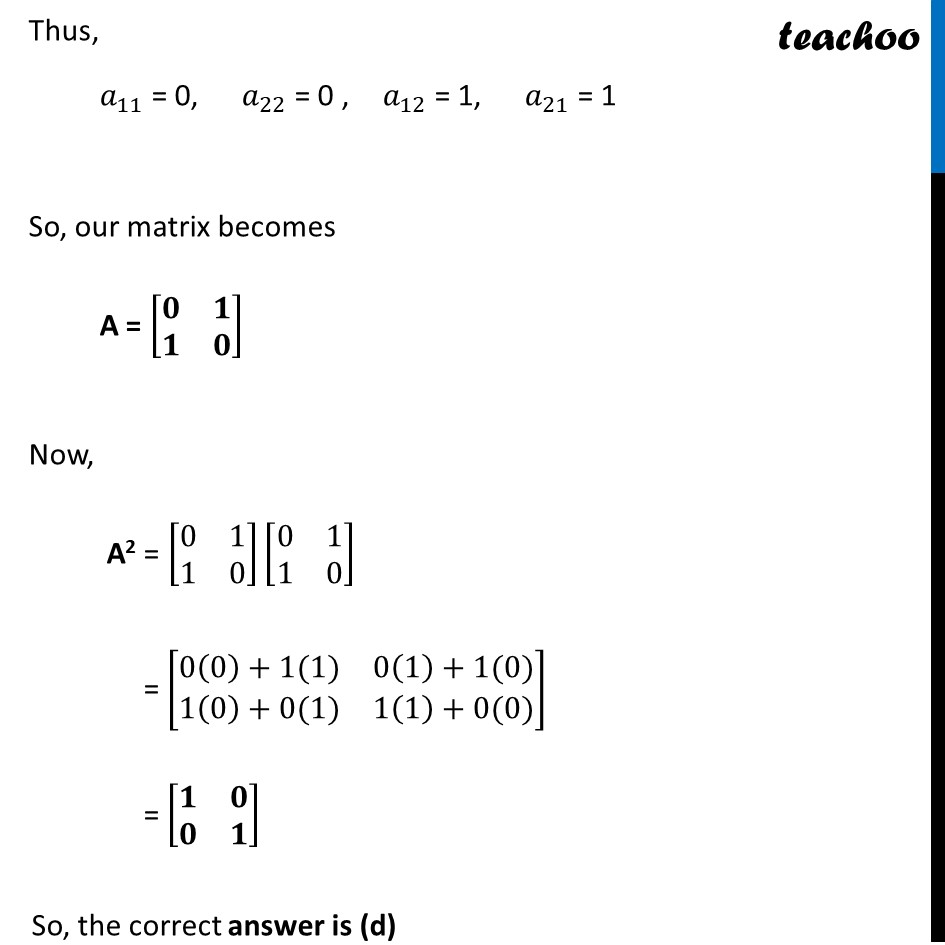If A = [aij] is a square matrix of order 2 such that aij = {(1, when i ≠j 0, when i=j )┤ , then A2 is :
(a) [8(1 0 1 0)] (b) [8(1 1 0 0)] (c) [8(1 1 1 0)] (d) [8(1 0 0 1)]
![Ques 3 (MCQ) - If A = [aij] is a square matrix of order 2 such that - CBSE Class 12 Sample Paper for 2022 Boards (MCQ Based - for Term 1)](https://cdn.teachoo.com/87d04962-cd93-4f65-bac3-7c3113a2aa94/slide7.jpg)

CBSE Class 12 Sample Paper for 2022 Boards (MCQ Based - for Term 1)
CBSE Class 12 Sample Paper for 2022 Boards (MCQ Based - for Term 1)
Last updated at Dec. 16, 2024 by Teachoo
![Ques 3 (MCQ) - If A = [aij] is a square matrix of order 2 such that - CBSE Class 12 Sample Paper for 2022 Boards (MCQ Based - for Term 1)](https://cdn.teachoo.com/87d04962-cd93-4f65-bac3-7c3113a2aa94/slide7.jpg)

Transcript
Question 3 If A = [𝑎𝑖𝑗] is a square matrix of order 2 such that 𝑎𝑖𝑗 = {█(1, 𝑤ℎ𝑒𝑛 𝑖 ≠𝑗@0, 𝑤ℎ𝑒𝑛 𝑖=𝑗 )┤ , then A2 is : (a) [■8(1&0@1&0)] (b) [■8(1&1@0&0)] (c) [■8(1&1@1&0)] (d) [■8(1&0@0&1)] For a 2 × 2 matrix A = [■8(𝑎_11&𝑎_12@𝑎_21&𝑎_22 )] Given that 𝑎_𝑖𝑗={█(1, 𝑖≠ 𝑗@0, 𝑖=𝑗)┤ Thus, 𝑎_11 = 0, 𝑎_22 = 0 , 𝑎_12 = 1, 𝑎_21 = 1 So, our matrix becomes A = [■8(𝟎&𝟏@𝟏&𝟎)] Now, A2 = [■8(0&1@1&0)][■8(0&1@1&0)] = [■8(0(0)+1(1)&0(1)+1(0)@1(0)+0(1)&1(1)+0(0))] = [■8(𝟏&𝟎@𝟎&𝟏)] So, the correct answer is (d)